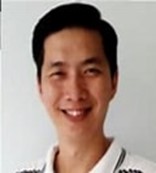 |
SPEAKER: Dr. Ng. Kok Jiunn
DESIGNATION: Snr Staff Engineer (RF)
COMPANY: TE Connectivity
SPEAKER’S BACKGROUND:
Dr. Ng Kok Jiunn was born in Teluk Intan, Perak, Malaysia in 1977. He received a B.Eng., M.S. and Ph.D. in electrical, electronic and system engineering from the National University of Malaysia, in 2000, 2004 and 2021 respectively. From 2004 to 2006, he was a Research Engineer with Anscom Sdn. Bhd. He was involved in the concealment solution and the pioneer research team for the Basestation Antenna Project. He was RF Engineer with Laird Technology (M) Sdn. Bhd. and Senior RF engineer with Amphenol Antenna Solution (M) Sdn. Bhd in the years 2006 and 2007 respectively. He designed various antennas for wireless routers and embedded antennas for portable devices such as laptops, handphones, dongles, etc. Since 2008, he has been with Laird Technologies(M) Sdn. Bhd. He led the antenna design team until 2013 and as Snr. Staff Engineer for Advance Technology Group in Antenna Division until 2021. Currently, he is in TE Connectivity as Principal Development Engineer. He holds more than 10 patents in various antenna designs. He has been involved in antenna projects including embedded antennas, MIMO antenna, portable radio antenna, RFID, LTE Distributed Antenna System platforms, vehicular antenna, M2M, DSRC, Wi-Fi infrastructure antenna etc. His research interests include embedded antenna, portable land mobile antenna, MIMO antenna, DAS antenna, array antenna, and Low PIM antenna. He is a member of IEEE.
ABSTRACT:
An antenna is the key element of wireless devices and technology. With the advancement of next-generation of wireless communication applications, antenna design concepts and techniques are becoming very important. Therefore, understanding the fundamental of antenna parameters and performance is increasingly critical to design a successful industrial antenna solution. This tutorial provides an introduction to antennas and their applications. It will present the technology shift that influences challenging requirements of antenna design in recent years. The tutorial will include an overview of antenna design challenges and design considerations for different types of industrial antenna.
|